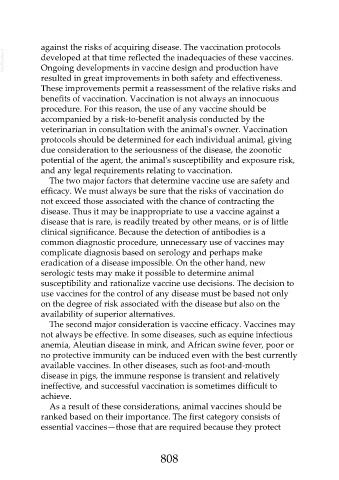Page 808 - Veterinary Immunology, 10th Edition
P. 808
against the risks of acquiring disease. The vaccination protocols
VetBooks.ir developed at that time reflected the inadequacies of these vaccines.
Ongoing developments in vaccine design and production have
resulted in great improvements in both safety and effectiveness.
These improvements permit a reassessment of the relative risks and
benefits of vaccination. Vaccination is not always an innocuous
procedure. For this reason, the use of any vaccine should be
accompanied by a risk-to-benefit analysis conducted by the
veterinarian in consultation with the animal's owner. Vaccination
protocols should be determined for each individual animal, giving
due consideration to the seriousness of the disease, the zoonotic
potential of the agent, the animal's susceptibility and exposure risk,
and any legal requirements relating to vaccination.
The two major factors that determine vaccine use are safety and
efficacy. We must always be sure that the risks of vaccination do
not exceed those associated with the chance of contracting the
disease. Thus it may be inappropriate to use a vaccine against a
disease that is rare, is readily treated by other means, or is of little
clinical significance. Because the detection of antibodies is a
common diagnostic procedure, unnecessary use of vaccines may
complicate diagnosis based on serology and perhaps make
eradication of a disease impossible. On the other hand, new
serologic tests may make it possible to determine animal
susceptibility and rationalize vaccine use decisions. The decision to
use vaccines for the control of any disease must be based not only
on the degree of risk associated with the disease but also on the
availability of superior alternatives.
The second major consideration is vaccine efficacy. Vaccines may
not always be effective. In some diseases, such as equine infectious
anemia, Aleutian disease in mink, and African swine fever, poor or
no protective immunity can be induced even with the best currently
available vaccines. In other diseases, such as foot-and-mouth
disease in pigs, the immune response is transient and relatively
ineffective, and successful vaccination is sometimes difficult to
achieve.
As a result of these considerations, animal vaccines should be
ranked based on their importance. The first category consists of
essential vaccines—those that are required because they protect
808

